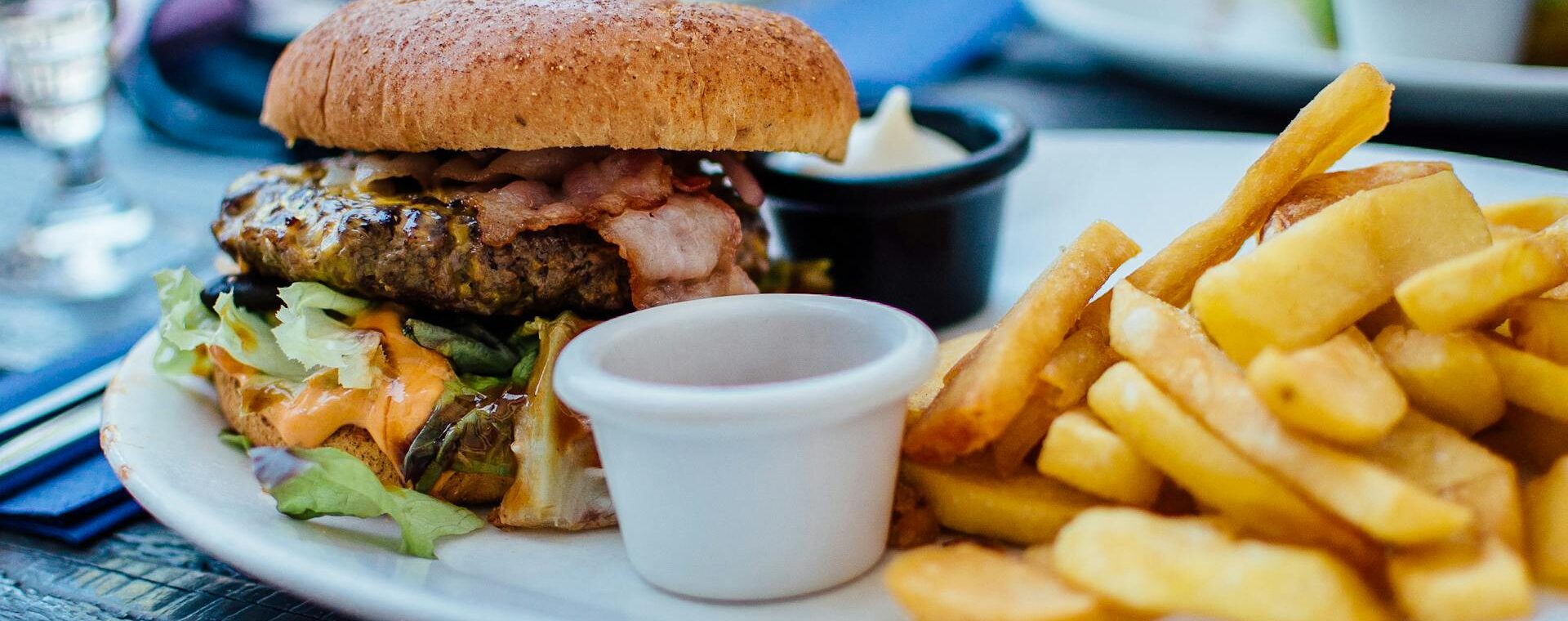Food is intrinsically linked to travel. Part of the exploration of a new country is trying out the national dishes and perhaps finding new favorites. But do people really know where their favorite foods come from?
To find out, Radical Storage surveyed 1,100 Americans to determine if they could guess the country of origin of 20 popular world famous foods.The results showed that people overwhelmingly don’t actually know which country their favorite foods comes from – guessing incorrectly an average of 60.24% per food item.
Let’s find out how many foods you can correctly locate.
Key findings
- People can’t correctly identify which country their food comes from 60.24% of the time on average.
- Nearly everyone (94.18%) struggled to correctly locate where Churros are from – the most commonly mistaken food origin in our study
- The 2nd and 3rd most confused food origins were for scotch eggs (91.82%) and donuts (90.18%)
- Pizza was the food that most people (78.73%) knew the country of origin of, followed by fajitas (70.64%) and hash browns (67.64%).
- The majority (87.64%) think it’s important to try local cuisines when visiting another country.
- Over half (54.55%) of people are confident that they know what countries their favorite foods are from.
- However, no one in the survey guessed all the food origins correctly, although everyone managed to guess at least one food origin correctly.
People can’t correctly identify which country their food comes from 60.24% of the time on average
In the survey food lovers were given a list of 20 popular world famous foods and asked to pick which country each was from. There was a choice of four countries to choose from per food.
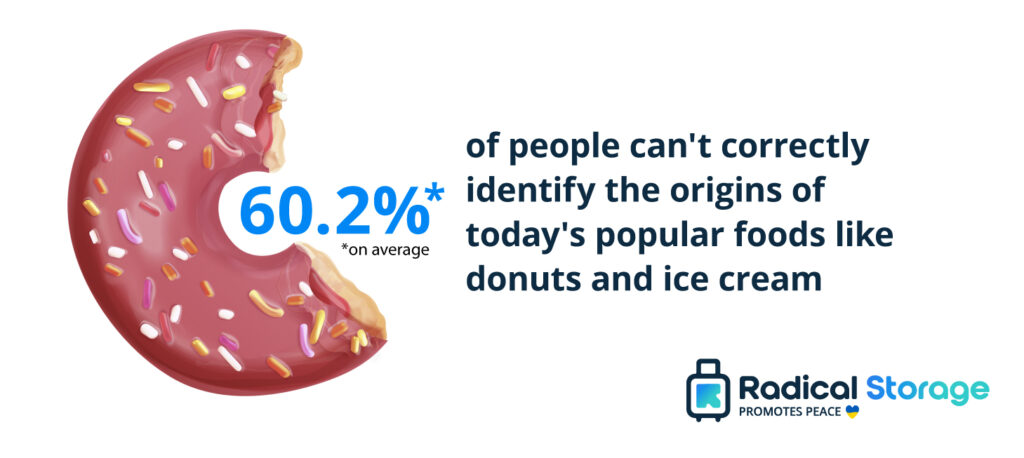
We wanted it to be a true test of their foodie expertise so included the correct country of origin, one country that the food that is incorrectly thought to have come from to act as a red herring, and then two other random countries to pick from.
The majority of respondents (87.64%) said that it’s also important to try local cuisines when visiting another country. Additionally 66.55% said that they think it’s important to know which country your food comes from.
However, the results show that on average people can’t correctly identify which country their food comes from 60.24% of the time. That’s despite, over half (54.55%) of people stating that they are confident that they know what countries their favorite foods are from.
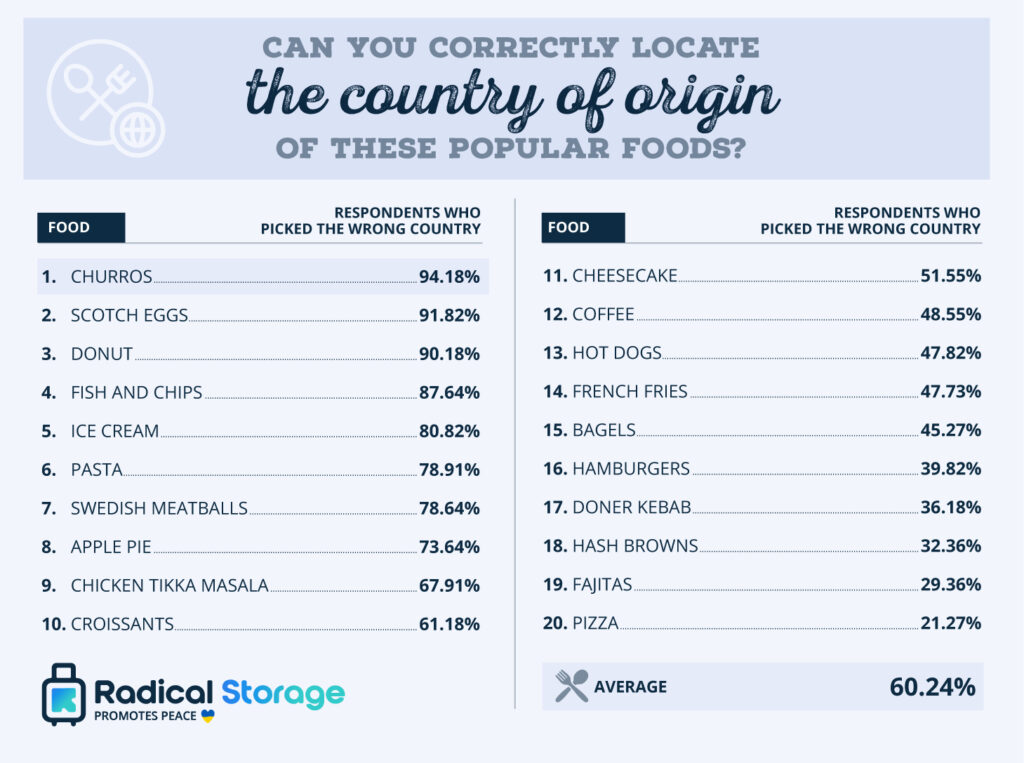
Pizza was the food that the majority (78.73%) of respondents were quick to correctly locate as coming from Italy, whereas a staggering 94.18% struggled to correctly identify that churros come from China. You can view all the correct countries of origin lower in the article.
Top 10 Hard To Identify Foods
The survey uncovered the top 10 hard to identify foods. Let’s take a look and see how many surprise you. The UK and Italy are joint first place for the highest number of incorrectly guessed origins, with two places each in the top 10 hard to identify foods.
If we look at the incorrectly picked origins for all 20 foods analyzed, then America was shown to be the country that most think their food comes from, taking five places as the most incorrectly guessed origin.
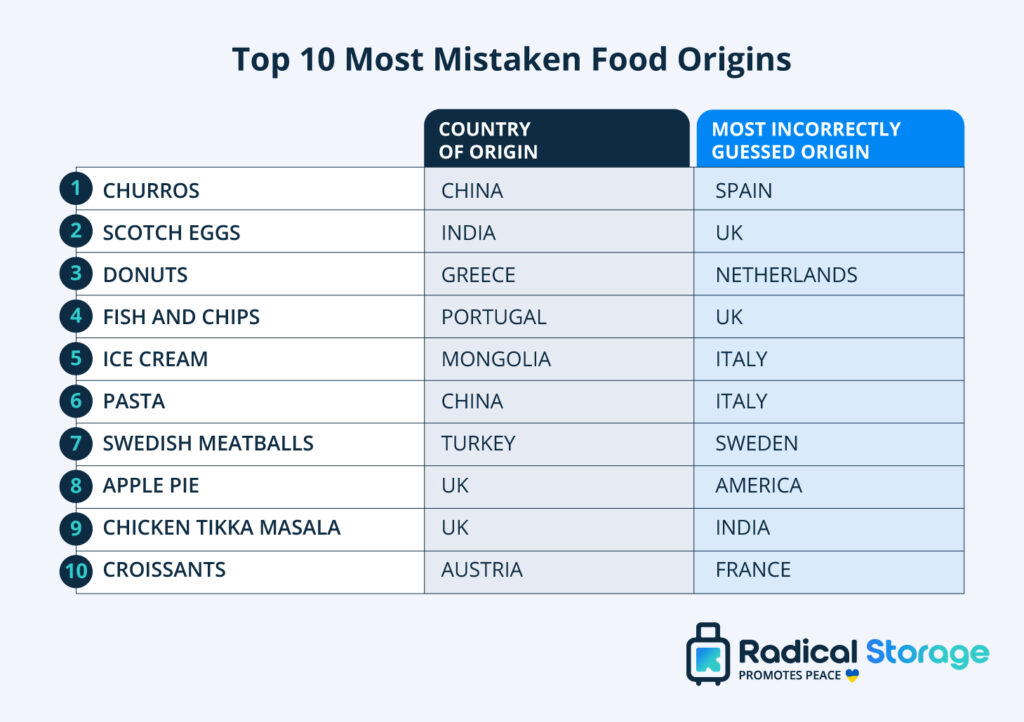
Churros
Often seen on the dessert menu at Spanish restaurants, churros are often mistaken for being from Spain. Nearly all (94.18%) of the survey respondents chose the wrong country of origin with 77.55% choosing Spain. However, they are in fact from China, which only 5.82% guessed correctly. Churros started off being known as Chinese fried dough or doughnut sticks and were often salted, rather than sweet. [1]
Scotch Egg
Scotch eggs are another delicacy that are often mistaken for coming from another country, mostly down to their name which implies that they are from Scotland, UK. Of the 91.82% who incorrectly chose the wrong country of origin 74.55% picked the UK – but it isn’t.
Only 8.18% correctly selected India as the birthplace of the Scotch Egg. Research from Amazing Food and Drink shows that India was the first country to invent this dish, taking inspiration from their nargisi kofta. There’s also theories that English soldiers returned home with the recipe in the 19th century. [2]
Donuts
The perfect accompaniment to a cup of coffee, donuts are a popular snack in America. However, their birthplace is much further afield. Their origin baffled 90.18% of respondents who incorrectly chose where they came from, with Netherlands being the top pick for 42.82% of people. But only 9.82% got it right, correctly answering that donuts are originally from Greece, although research shows that they used to go by the name fried dough or loukoumades. [3]
Fish and Chips
Quintessential with British culture, it could be understandable to presume that fish and chips started off life in the UK. Of the 87.64% respondents who incorrectly picked the country of origin for the dish, 75.82% selected the UK as their answer. Only 12.36% of the respondents picked correctly, answering that fish and chips are in fact from Portugal. Needing a simple and easy dish during the depression it became a staple in Portuguese cuisine in the 15th century. [4]
Ice Cream
Ice cream comes in many flavors. We’re spoilt for choice. But could you correctly locate the country it comes from? 80.82% of survey respondents couldn’t, with nearly half (49.91%) thinking it came from Italy. The cold creation actually comes from Mongolia, which 19.18% chose correctly. [5] The original version was made of frozen milk, far from the flavorful dessert we know today.
Pasta
Pasta is a beloved meal across the globe, and while you might think its origins are based in Italy, you’d be wrong. 78.91% of people struggled to pick the right origin country for the dish. Over half (66.82%) of respondents said Italy was the birthplace of pasta. But it is in fact China. [6] The theory is that pasta descended from the Asian staple that is noodles.
Swedish Meatballs
The name Swedish meatballs could easily mistake you into thinking they derive from Sweden, but that’s not the truth. Of the 78.64% respondents who chose the wrong country of origin, 64.91% unsurprisingly picked Sweden. But they actually come from Turkey. A viral post on X (formally Twitter) in April 2018 from Sweden’s official account stated that the delicacy arrived on their lands in the 18th century by King Charles XII. [7]
The confusion with Sweden is down to the meat used. Swedish meatballs originally used beef, whereas nowadays some use pork which isn’t considered Halal meat in Turkey and its inclusion looks to be a Swedish invention. [8]
Apple Pie
Apple pie is pure Americana, but is in fact not from the United States. Nearly three quarters of respondents (73.64%) failed to correctly guess the origin country of the sweet dessert. The most common incorrect answer was America chosen by 43.82% of respondents. The dish can actually be traced back to the UK, which 26.36% got right.
According to Food52, apple pie first originated in England, with culinary influences from France, the Netherlands, and the Ottoman Empire. In fact, apple trees weren’t native to North America until Europeans arrived. [9]
Chicken Tikka Masala
You may think that you know the birthplace of Chicken Tikka Masala, but think again. 67.91% of respondents failed to correctly answer which country the dish comes from, with the most common incorrect answer from 50.82% being India. Chicken Tikka Masala was first seen in Scotland, which 32.09% chose correctly. Research shows that the chef who invented the dish was a Bengali chef who lived in Glasgow in the 1970s. The dish went on to gain huge recognition and became one of the most popular foods in the UK. [10]
Croissants
It’s impossible to even say the word croissant without sounding French, but they aren’t actually from the gastronomic capital of Europe which may come as a surprise. The majority (61.18%) of respondents couldn’t correctly place where they come from, with nearly half (47.45%) picking France. However, 38.82% were spot on. Croissants started off life in Austria known as kipferl. They were originally sweet and flavored with vanilla and enjoyed during the festive season. [11]
Top 10 Easily Identified Foods
We’ve covered which foods people found hard to identify the original country of origin for, but which ones turned out to be much easier to pinpoint?
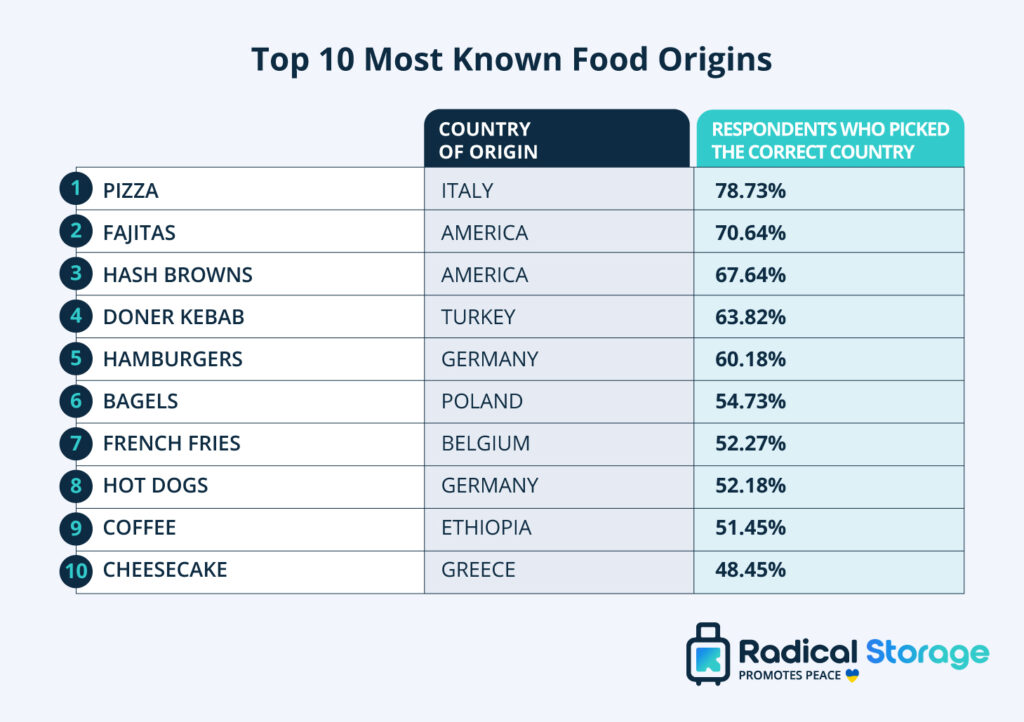
Pizza
Pizza was shown to be the food staple that people were able to correctly identify the country of origin. In fact, with the highest percentage in the study 78.73% of respondents correctly selected Italy as the birthplace of pizza. [12] The remaining 21.27% missed out on a slice of the action, with the most common incorrect country picked for pizza being America.
Pizza may be one of America’s favorite foods [13], but according to HelloFresh the first recorded pizza documented by name was in 997 CE in southern Italy. However, they state that the pizza we know and love today started life in 18th-century Naples. [14]
Fajitas
In second position for food that the majority of people (70.64%) picked the correct country of origin for is fajitas. The flavorsome food originally comes from America, which most seemed to be aware of. However, 29.36% of respondents chose the wrong country of origin, with the most common incorrect country selected being Turkey.
Research shows that although fajitas are often thought of as coming from Mexico, their roots lie in Texas. Fajitas were first introduced in Rio Grande Valley in the early 1930s. [15]
Hash Browns
The ultimate accompaniment to any breakfast, hash browns were shown to be a food that people could easily pick the country of origin for. Most people (67.64%) correctly guessed that the potato snack was originally from America. According to the Tasting Table the first mention of a “hash brown” dish was in 1835 in the Minnesota Farmers’ Institute Annual. [16] Over a third (32.36%) of respondents failed to correctly identify where they came from with the most common incorrect country chosen being the UK (19.55%).
Doner Kebabs
Taking fourth place was doner kebabs which 63.82% of respondents answered correctly as coming from Turkey. The doner kebab originated in Turkey in the 19th century, but the modern sandwich version we know today first became popular in Poland in the 1990s. [17] The second most common country chosen for the birthplace of the doner kebab was Germany at 15.55%.
Hamburgers
You could be forgiven for thinking that hamburgers originated in America given the growth of franchises like McDonald’s, Burger King and Wendy’s. In fact 30.73% of respondents picked America as the country the food stable came from. However, 60.18% of respondents guessed correctly and selected Germany as the home of the hamburger. According to Amazing Food and Drink hamburgers first appeared in Germany before becoming popular in other countries. The origin of the hamburger is said to be the German city of Hamburg – hence the name. [18]
Bagels
Can you identify the origin country of Bagels? Would you say America? Well 19.73% chose that as the origin country of the Bagel, but they were wrong. Over half (54.73%) of respondents correctly picked Poland as the birthplace of the ring-shaped snack. There are so many myths that surround the invention of the Jewish-American culinary icon. According to the National Geographic bagels can be traced back to 13th century Jewish bakers in a part of Eastern Europe that is now known as Poland. [19]
French Fries
More than half of respondents weren’t fooled by the country in the name French fries, 52.27% stated correctly that the potato fry was in fact from Belgium. [20] Belgium’s dominant language is French, so that could perhaps be how the crunchy snack got their infamous name. Over a quarter of the survey respondents (25.73%) were fooled by the name though and chose France as the origin country of the fried dish.
Hot Dogs
Synonymous with baseball games [21], hot dogs are originally from Germany, coming to life first in the city of Frankfurt in the 15th century where, according to Amazing Food and Drink, they were referred to as dachshund sausages due to their shape. [22] 52.18% of respondents correctly identified Germany as the country of origin, while the other 47.82% couldn’t correctly identify its birthplace with the most common wrong answer being America at 27.64%.
Coffee
We’re often spoiled for countries to get coffee beans from, but do people know where the first example of coffee came from? Over half of respondents, 51.45% correctly selected Ethiopia. Research shows that before the likes of Brazil and Colombia dominated the coffee market, Ethiopia was the mainland for cultivating beans. [23] Columbia was the most common incorrect country picked at 28.64%.
Cheesecake
The last food item in the top 10 easily identified foods is cheesecake. With the success of chain The Cheesecake Factory and popularity of New York cheesecake, it would be understandable to think that the sweet treat is from America. In fact 20.09% of respondents chose America as the home of the cheesecake. However, it’s actually from Greece [24], which 48.45% of survey respondents selected correctly. The very early version of the cheesecake made by the ancient Greeks was slightly different to the one we know today, but no doubt still delicious.
So there you have it, how many foods did you correctly guess the country of origin for?
Methodology
In September 2024, we surveyed 1,100 Americans asking them to select the correct country of origin of 20 popular foods from around the world.
The survey gave a choice of four countries to choose from per food providing respondents a 25% chance of getting the correct answer each time. The four countries listed per food included the correct country of origin, one country that the food is incorrectly thought to have come from but isn’t, and then two other random countries to pick from.
Respondents were also asked questions about the importance of knowing the origins of your food.
The list of the 20 popular foods was compiled from a number of sources which are listed below.
The demographics of those surveyed were:
Gender
- Male (39.91%)
- Female (58.91%)
- Non-binary (0.91%)
- Preferred not to disclose (0.27%)
Age
- 18-27 (13.91%)
- 28-43 (64.91%)
- 44-59 (15.64%)
- 60+ (5.55%)
Sources
- https://amazingfoodanddrink.com/most-popular-foods-origins/
- https://amazingfoodanddrink.com/most-popular-foods-origins/
- https://amazingfoodanddrink.com/most-popular-foods-origins/
- https://amazingfoodanddrink.com/most-popular-foods-origins/
- https://amazingfoodanddrink.com/most-popular-foods-origins/
- https://amazingfoodanddrink.com/most-popular-foods-origins/
- https://twitter.com/swedense/status/990223361648275456
- https://amazingfoodanddrink.com/most-popular-foods-origins/
- https://food52.com/blog/24688-apple-pie-origin-story
- https://amazingfoodanddrink.com/most-popular-foods-origins/
- https://amazingfoodanddrink.com/most-popular-foods-origins/
- https://www.hellofresh.com/eat/history-of-food/history-of-pizza
- https://eu.usatoday.com/story/money/food/2018/09/27/national-pizza-month-favorite-food/1430139002/
- https://www.hellofresh.com/eat/history-of-food/history-of-pizza
- https://amazingfoodanddrink.com/most-popular-foods-origins/
- https://www.tastingtable.com/1170875/the-hazy-origin-of-hash-browns/
- https://www.nationalgeographic.com/travel/article/what-is-turkish-doner-kebab
- https://amazingfoodanddrink.com/most-popular-foods-origins/
- https://www.nationalgeographic.com/history/article/bagel-history-jewish-american-culture-symbol
- https://amazingfoodanddrink.com/most-popular-foods-origins/
- https://www.mlb.com/news/history-of-iconic-mlb-ballpark-food-explained
- https://amazingfoodanddrink.com/most-popular-foods-origins/
- https://amazingfoodanddrink.com/most-popular-foods-origins/
- https://amazingfoodanddrink.com/most-popular-foods-origins/
Sources correct as of September 2024.

This work is licensed under a Creative Commons Attribution-ShareAlike 4.0 International License.

